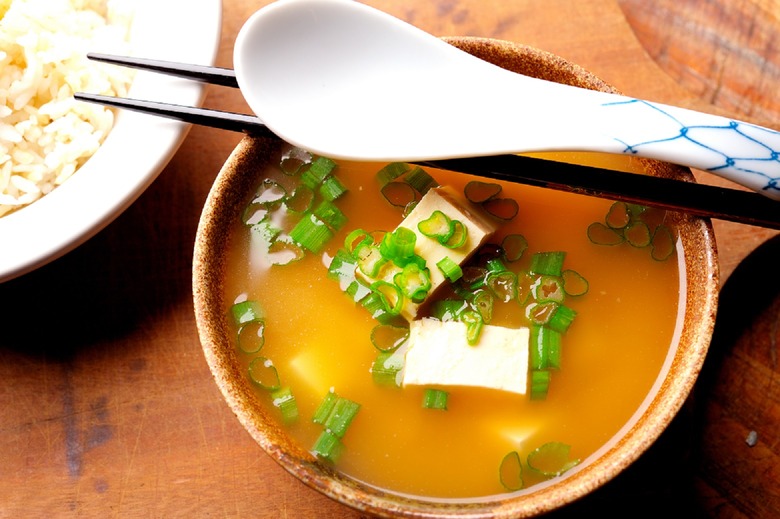What Is Miso Soup?
Miso soup is a simple combination of dashi (a Japanese soup stock typically made from bonito flakes, kelp, and anchovy) and miso (a fermented paste often made from soybeans). It's a familiar and comforting sight, taste, and smell for anyone who has eaten at a typical neighborhood Japanese restaurant and been greeted warmly by shouts of "Irasshaimase!" roughly meaning "Come on in!" or "Welcome!" from the staff.
First things first: Just what is the cloudy stuff that settles toward the bottom of the bowl? Leave the soup untouched and one will see it seemingly separate, with a clear broth surrounding the "cloud." Stir it up again and it's whole, just as it was before. Mysterious? Indeed.
That "stuff" is the miso paste. Unlike salt or sugar, it never really dissolves in the dashi broth to form a solution. So, if left alone long enough, the particles of miso fall to the bottom and separate.
Click here to see the Miso Soup Recipe.
OK, mystery solved. Now, second question: How can one make it at home? Well, it's quite easy actually. It's one of those dishes for which it's almost unnecessary to have a recipe. The most challenging part probably isn't making the soup, but rather finding the ingredients. A trip to an Asian supermarket or Japanese grocery store would be ideal, but sometimes the neighborhood store will carry miso paste, often in the refrigerated section next to the salad dressings. Chicken stock, although not ideal, may be used as a substitute for dashi broth in a pinch.
For the most traditional flavor, though, it's best to look for dashi packets or boxes of hondashi powder, which often come in MSG-free versions. These ready-made versions are easy to make and require only several minutes of simmering in hot water to create a dashi broth. They can often be found in the same aisle as the packages of dried udon and soba noodles, but if they're hard to find, just ask around. (Photo courtesy of Wikimedia/Franzeska)
Next up — what type of miso to buy? There are many varieties out there, and it can be a bit mind-boggling. While a bit of buy-and-try experimentation is fun sometimes, it does also help to have a few guidelines before diving in. Miso comes in different colors — namely, white, yellow, red, and brown. As a general rule of thumb, darker miso has a much more pronounced flavor than lighter miso because it has been aged for a longer period of time. Miso can vary in salt level and can also be made from barley and rice in addition to soybeans, or all three in combination. Miso should always be kept refrigerated to maintain freshness. (Photo courtesy of flickr/pinprick)
OK. Dashi: check. Miso: check. Now it's time to make the soup. What are some things to watch out for? Well, it probably isn't apparent just how much miso to use. How much is too much, and how much is too little? It may depend on the saltiness of the particular brand of miso, but a good ratio to keep in mind as a starting point is about 15 grams of miso for every cup of dashi broth.
What are some pitfalls to watch out for? Well, the most important thing is to avoid bringing the soup to a boil once the miso paste has been dissolved into the dashi broth. This will cause the miso to break down and result in a miso soup with poor flavor. It cannot be emphasized enough. So please, do not boil the soup once the miso has been added. Actually, that's pretty much the only pitfall. Add tiny cubes of silken tofu and some chopped scallions to dress it up just before serving, and that's pretty much it. Enjoy!
